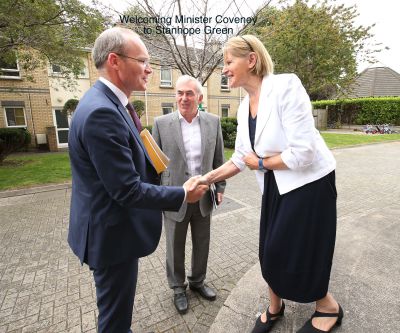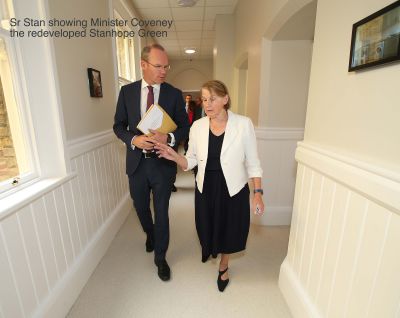
 In September Focus Ireland released its annual report at its newly redeveloped housing in Stanhope Green in Dublin where it provides accommodation in 71 units (61 single units and 10 families) for people who were previously homeless. In this article you can read the Address by Sr. Stainslaus Kennedy at the Reopening at which Minister for Housing Simon Coveney was present.
In September Focus Ireland released its annual report at its newly redeveloped housing in Stanhope Green in Dublin where it provides accommodation in 71 units (61 single units and 10 families) for people who were previously homeless. In this article you can read the Address by Sr. Stainslaus Kennedy at the Reopening at which Minister for Housing Simon Coveney was present.
It is just 200 years ago since this building now known as Stanhope Green was built to become the first Novitiate of the Religious Sisters of Charity which had just been founded by Mary Aikenhead.
In 1819 Mary Aikenhead established her second foundation in Stanhope Street, Dublin on the grounds of a refuge run by Mrs. O’Brien and her associates. There she built a convent and chapel which was the first Noviciate of the Religious Sisters of Charity. On 2nd February 1819 Mass was celebrated in the chapel and the convent was blessed and opened. From 1819 to 1826 Mary Aikenhead lived in Stanhope Street devoting most of her time to the formation and training of novices and young sisters.
The Stanhope Street Convent, as it was known then, was a beacon of light in this part of the city, bringing many new services to the sick, the poor, the imprisoned, the dying, abandoned children and many others.
This included working in Kilmainham prison with women, particularly those on death row, and in Grange Gorman Hospital which had been temporarily set up as a cholera hospital at that time as Asiatic cholera swept through Europe and Ireland.
 The conditions in the hospital were appalling. The Sisters of Charity Annals describes as many as 8 people dying in one makeshift bed in one day. This is now Grangegorman DIT and was opened in 2015.
The conditions in the hospital were appalling. The Sisters of Charity Annals describes as many as 8 people dying in one makeshift bed in one day. This is now Grangegorman DIT and was opened in 2015.
So for nearly 200 years, Stanhope Street convent was a hive of activity providing a whole range of good works and services in this area of Dublin town. This included establishing two schools and the Stanhope Treatment Centre for people with addictions.
Towards the end of the last century in the late 1980s the sisters decided to vacate the convent and work and live in a smaller convent nearby.
This decision coincided with the founding of Focus Ireland (then Focus Point) in 1985.
In Focus Point we had three ambitious aims:
1. to prevent people getting into the cycle of homelessness,
2. to help people out of homelessness
3. and to work towards the elimination of homelessness.
Our vision was that “everyone has a right to a place they can call home” and that is still the vision of Focus Ireland today.
Very early on in the history of Focus Point it became clear that the only way to help people out of homelessness was to provide them with access to a home. The delivery of homes was the key to solving homelessness.
In Focus Point we campaigned vigorously for a change in legislation with regard to homelessness and in 1988 the Housing Act was passed and for the first time homelessness was recognised and defined in Law and the need to provide housing for homeless people was recognised by the state.
Up to that point it was assumed that homeless people only needed a hostel for shelter and a food centre for food.
What we in Focus Point also realised at an early stage was that a range of housing options was needed if it was to combat homelessness, no one option was enough.
With that in mind I requested the then congregational leader of the Religious Sisters of Charity, Sr. Francis Ignatius Fahy, for Stanhope Street Convent to provide housing for homeless people who needed not only housing, but other supports also. My request was responded to with great generosity. The congregation gave the convent free gratis and for nothing to Focus Point. We then had to convince the Minister for Environment Padraigh Flynn to provide funding to convert the convent.
 The Department of the Environment were not impressed or interested in the proposal at first but after many meetings and negotiations agreed and in 1988 the government provided 1 million Irish punts in the budget for the conversion of Stanhope Street Convent.
The Department of the Environment were not impressed or interested in the proposal at first but after many meetings and negotiations agreed and in 1988 the government provided 1 million Irish punts in the budget for the conversion of Stanhope Street Convent.
This was the first time ever that state funding was made available to provide housing for people who were homeless. Stanhope Green was a milestone in the development of good quality low cost housing for people who were homeless in Ireland.
Eventually the Stanhope Green project came to be seen by the Department of the Environment as a “flagship development” and because of Focus Point’s emphasis on high standards it was nicknamed the ‘Focus Hilton’. The convent was converted into 96 small but high standard, good quality housing units and 10 family houses. The apartments were small but they were beautiful. Each had their own key to their hall door and had a bedroom, their own kitchen and bathroom. Also there were communal facilities including a communal sitting room, a restaurant, a laundry, and an enterprise room. A place to call their own with security of tenure was a far cry from the awful conditions under which the new tenants were living previously. I know from speaking to the tenants at different times over the years the real life changing difference having a home – with support from our staff if required – has made to their lives.
It was the first large scale social housing project for people who were homeless in Ireland. The first residents moved in 1991. Its philosophy was to encourage people to live as independently as they could while at the same time providing the level of support that each individual needed.
The selection of tenants was done with great care to ensure diversity in terms of need, gender and age.
The reception of each tenant was done with equal good care and attention. Each tenant was unique and special and the bunch of flowers and card for each tenant when they arrived in their apartment reflected the values of Stanhope Green.
In 2011, when funding was scarce, Focus Ireland committed to a 3 million renovation of the now 20 year old housing development to upgrade the accommodation to 21st century expectations and to provide what we have here today, 71 beautiful modern homes comprised of 61 single units and 10 families. (This funding was raised by Focus Ireland through fundraising)
This again is keeping with the spirit and values of Focus Ireland.
There are many lessons to be learned from the story of Stanhope Green.  One important lesson is that the only way to help people out of homelessness is to provide them with access to a home. The delivery of homes is the only key to solving the housing situation. The second lesson is that a range of housing options are needed to solve homelessness, no one option is the answer.
One important lesson is that the only way to help people out of homelessness is to provide them with access to a home. The delivery of homes is the only key to solving the housing situation. The second lesson is that a range of housing options are needed to solve homelessness, no one option is the answer.
This is as true today as it was 25 years ago.
Stanhope Green is a great success story and it is thanks to so many people especially those who at its beginning trusted the idea.
The Religious Sisters of Charity,
Department of Environment
Dublin City Council,
The architect who oversaw the project did it with great sensitivity and creativity
Focus Housing Association / Board of Directors
It is thanks to all the tenants who have lived and are still living here and have made Stanhope Green their home, five of whom are here from the beginning.
Thanks to all the staff who have worked here especially the early staff who laid the foundation for high standards and good quality housing and hospitality, especially Eamonn Martin, Pat Mooney, Sile Wall and Catherine Farrelly. Thanks also to Judy Mahoney, Jean Quinn and Grainne Hilton who worked with the families and the many others who followed.
Today as we launch our Focus Ireland annual report for 2015 and reopen Stanhope Green it is clear the core belief of the organisation remains the same, that is that providing homes is central to tackling homelessness.
In Focus Ireland we provide houses for 670 families and individuals and we are proud to announce today our plans to double our housing stock and to provide 600 more homes over the next four years to help tackle the worst homeless crisis since the foundation of the state.







